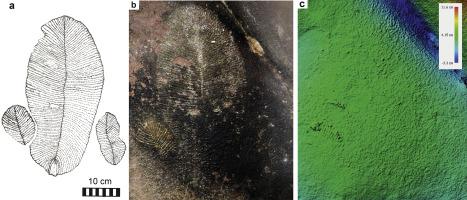当前位置:
X-MOL 学术
›
Gondwana Res.
›
论文详情
Our official English website, www.x-mol.net, welcomes your
feedback! (Note: you will need to create a separate account there.)
Dickinsonia discovered in India and late Ediacaran biogeography
Gondwana Research ( IF 7.2 ) Pub Date : 2021-02-01 , DOI: 10.1016/j.gr.2020.11.008 Gregory J. Retallack , Neffra A. Matthews , Sharad Master , Ranjit G. Khangar , Merajuddin Khan
Gondwana Research ( IF 7.2 ) Pub Date : 2021-02-01 , DOI: 10.1016/j.gr.2020.11.008 Gregory J. Retallack , Neffra A. Matthews , Sharad Master , Ranjit G. Khangar , Merajuddin Khan

|
Abstract The discovery of Dickinsonia in India allows assessment of biogeographic provinces and plate tectonic reconstructions for the late Ediacaran. The fossils were found in the roof of Auditorium Cave at Bhimbetka Rock Shelters, a UNESCO World Heritage Site for Paleolithic and Mesolithic cave art, near Bhopal, Madhya Pradesh. The fossils are identical with Dickinsonia tenuis from the Ediacara Member of the Rawnsley Quartzite in South Australia, and like them also show deformation due to lateral impingement, arcuate pieces missing, and alignment. They are within the late Ediacaran, Maihar Sandstone of the Bhander Group, in red sandstones formed in coastal plain paleoenvironments, including eolian, tsunamite, and intertidal bedforms. This new occurrence confirms assembly of Gondwanaland by 550 Ma, but not reconstructions adjusted for true polar wander. Cloudina and other small shelly marine fossils were low latitude, but vendobionts such as Dickinsonia were at temperate to subtropical latitudes.
中文翻译:

Dickinsonia在印度和埃迪卡拉纪晚期生物地理学中发现
摘要 Dickinsonia 在印度的发现可以评估埃迪卡拉纪晚期的生物地理省份和板块构造重建。这些化石是在 Bhimbetka Rock Shelters 的礼堂洞穴屋顶发现的,该洞穴是联合国教科文组织世界遗产,位于中央邦博帕尔附近,是旧石器时代和中石器时代洞穴艺术的世界遗产。这些化石与来自南澳大利亚 Rawnsley 石英岩 Ediacara 成员的 Dickinsonia tenuis 相同,并且像它们一样也显示出由于横向撞击、弓形碎片丢失和对齐而导致的变形。它们位于埃迪卡拉纪晚期、班德群的迈哈尔砂岩中,位于沿海平原古环境中形成的红色砂岩中,包括风成、海啸和潮间带床型。这一新事件证实了 550 Ma 之前冈瓦纳大陆的组装,但不是为真正的极地漂移调整的重建。Cloudina 和其他小型贝壳海洋化石属于低纬度地区,但 Dickinsonia 等小型海洋生物则处于温带至亚热带纬度。
更新日期:2021-02-01
中文翻译:

Dickinsonia在印度和埃迪卡拉纪晚期生物地理学中发现
摘要 Dickinsonia 在印度的发现可以评估埃迪卡拉纪晚期的生物地理省份和板块构造重建。这些化石是在 Bhimbetka Rock Shelters 的礼堂洞穴屋顶发现的,该洞穴是联合国教科文组织世界遗产,位于中央邦博帕尔附近,是旧石器时代和中石器时代洞穴艺术的世界遗产。这些化石与来自南澳大利亚 Rawnsley 石英岩 Ediacara 成员的 Dickinsonia tenuis 相同,并且像它们一样也显示出由于横向撞击、弓形碎片丢失和对齐而导致的变形。它们位于埃迪卡拉纪晚期、班德群的迈哈尔砂岩中,位于沿海平原古环境中形成的红色砂岩中,包括风成、海啸和潮间带床型。这一新事件证实了 550 Ma 之前冈瓦纳大陆的组装,但不是为真正的极地漂移调整的重建。Cloudina 和其他小型贝壳海洋化石属于低纬度地区,但 Dickinsonia 等小型海洋生物则处于温带至亚热带纬度。











































 京公网安备 11010802027423号
京公网安备 11010802027423号